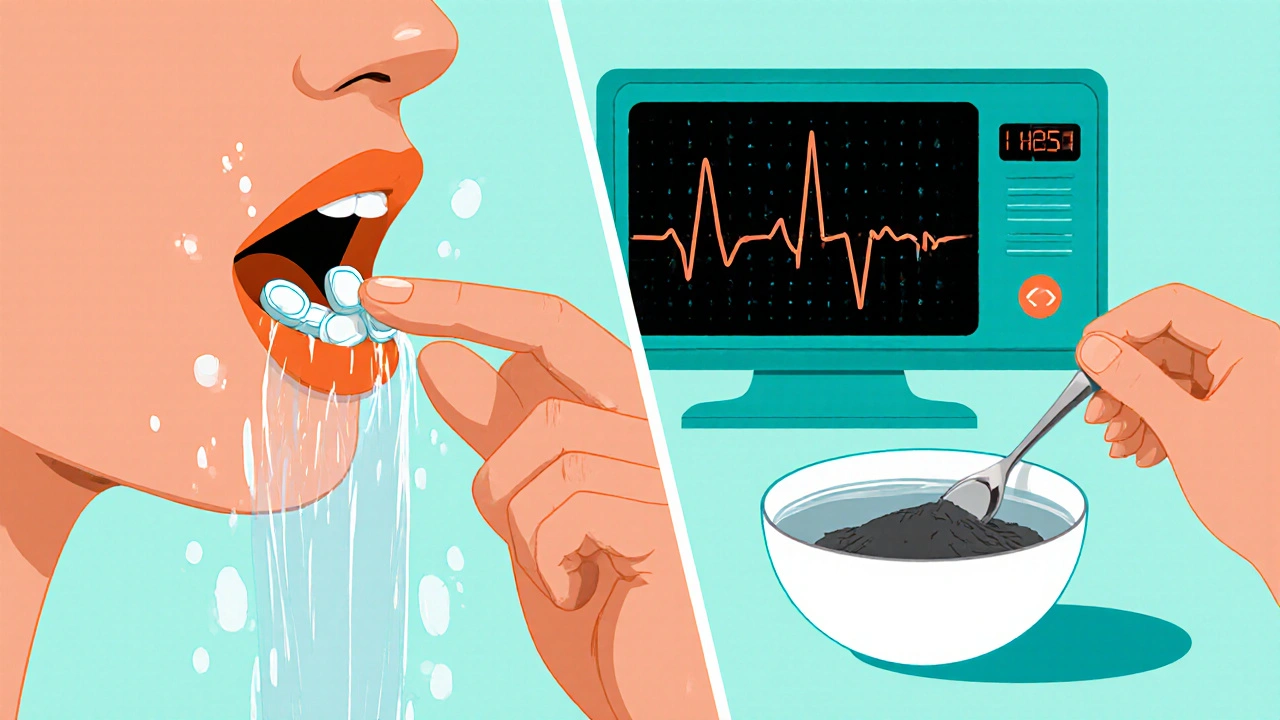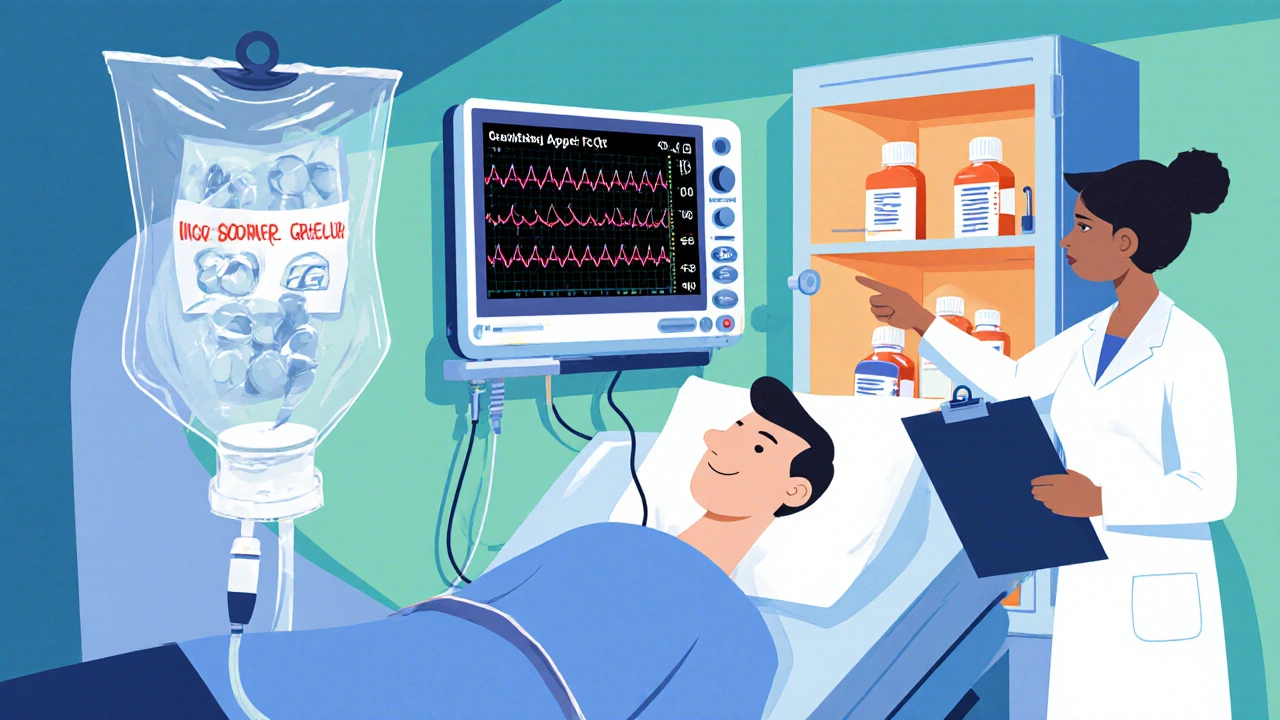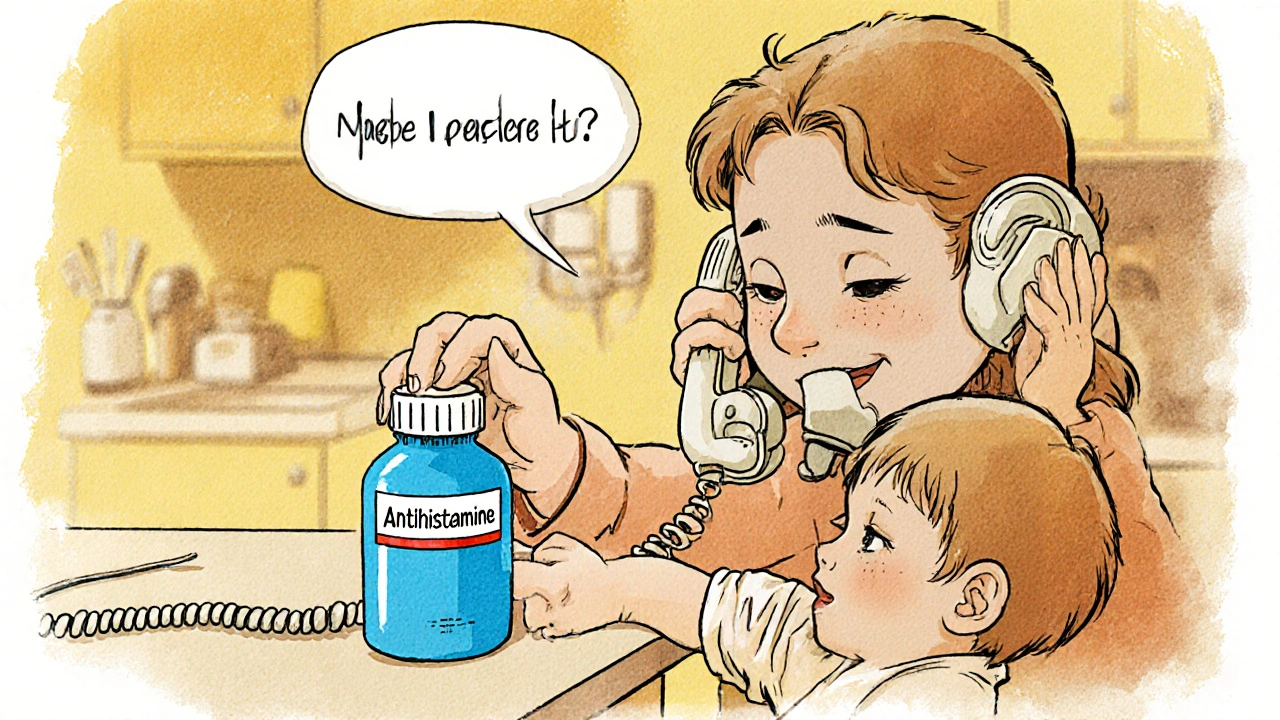Activated Charcoal Dosage Calculator
How to Use This Calculator
Enter patient information below to calculate the appropriate activated charcoal dose for antihistamine overdose. Remember: activated charcoal is only effective within 1-2 hours after ingestion and should not be given if the patient is unconscious or has a compromised airway.
- Activated charcoal is only effective within 1-2 hours after ingestion
- Do NOT give charcoal if patient is unconscious or has compromised airway
- Do NOT give charcoal if patient is already vomiting
- Charcoal is most effective for first-generation antihistamines (diphenhydramine, etc.)
- Always call poison control first before administering any treatment
Results
Key Takeaways
- Call poison control right away; give them the medication name, amount, and timing.
- Do not induce vomiting unless instructed by a professional.
- Activated charcoal can limit absorption if given within 1‑2 hours of ingestion.
- Watch for cardiac signs such as rapid heartbeat or widening QRS on an ECG.
- First‑generation antihistamines (e.g., diphenhydramine) need closer monitoring than second‑generation types.
When someone swallows too much antihistamine overdose is a potentially life‑threatening situation that demands quick, calm action. Whether it’s a curious toddler finding a bottle of Benadryl or an adult taking a large dose for a bad sleep, the first few minutes determine whether complications like cardiac arrhythmias or severe respiratory depression develop. This guide walks you through the exact steps to take from the moment you suspect an overdose until help arrives, focusing on practical first aid, when to call emergency services, and what hospitals will do once you’re there.
Recognising an Antihistamine Overdose
Antihistamines come in two generations. The older, first‑generation drugs (diphenhydramine, chlorpheniramine, promethazine) cross the blood‑brain barrier and cause strong anticholinergic, alpha‑adrenergic and sodium‑channel blocking effects. The newer, second‑generation agents (loratadine, cetirizine, fexofenadine) generally cause milder symptoms, but massive amounts can still be dangerous.
Typical red‑flag signs include:
- Profuse dry mouth, flushed skin, and dilated pupils
- Extreme drowsiness turning into agitation or seizures
- Rapid, pounding heart rate (tachycardia) or irregular rhythm
- Difficulty urinating, constipation, or urinary retention
- Blurred vision, hallucinations, or confusion
- Signs of cardiac toxicity on an electrocardiogram (ECG), especially widening of the QRS complex beyond 100 ms
In children under six, even modest doses can trigger severe anticholinergic toxicity, so a high index of suspicion is essential.
Immediate Actions: Call for Help
The very first step is to contact a poison‑control centre. In the United States, the number is 1‑800‑222‑1222; many other countries have similar 24/7 hotlines. Have these details ready:
- Exact name of the antihistamine (e.g., diphenhydramine, loratadine).
- Estimated amount taken (mg or mL) and the time of ingestion.
- Age and weight of the person.
- Any symptoms already observed.
Poison‑control experts will tell you whether you can stay at home and observe, or whether you need to head to the emergency department right away. Do not wait for symptoms to worsen.
Do Not Induce Vomiting
A common myth is that making the person vomit will get the drug out. In reality, forced vomiting increases the risk of aspiration, especially because antihistamines often cause drowsiness and a compromised gag reflex. Follow the poison‑control centre’s advice-usually they will say “no vomiting” unless a professional deems it safe.
Decontamination and Removing Residue
If tablets or capsules are still in the mouth, carefully remove any remaining pieces with clean fingers or a suction device if one is available. Rinse the mouth with water, but do not give anything to drink unless instructed.
For liquid formulations that have spilled on skin, flush the area with water for at least 15 minutes. If the eyes are exposed, keep rinsing with cool water for 20 minutes. These steps limit additional absorption through skin or mucous membranes.

Activated Charcoal: When and How to Use It
Activated charcoal binds many oral toxins, including most antihistamines, if given within the first 1‑2 hours after ingestion. The usual adult dose is 25‑100 g (about 1‑2 Tbsp of powdered charcoal mixed with water). For children, give 0.5‑1 g per kilogram of body weight.
Key points:
- It works best if the person is fully conscious and can protect their airway. \n
- Never give charcoal if the patient has a compromised airway, is seizing, or has already vomited a large amount.
- Charcoal does not bind well to metals, alcohol, or certain acids, but it is effective for diphenhydramine and similar H1 blockers.
If you are unsure, the poison‑control operator will guide you on whether charcoal is appropriate.
Cardiac Monitoring and the Role of the ECG
First‑generation antihistamines can block sodium channels, leading to a widened QRS complex on an ECG-an early warning sign of potentially fatal arrhythmias. Hospitals will place the patient on continuous cardiac monitoring if the ingested dose exceeds 300 mg for adults or if the child’s estimated dose is above the 7.5 mg/kg threshold.
Typical findings and interventions:
- QRS > 100 ms: Consider intravenous sodium bicarbonate.
- Heart rate > 120 bpm with hypotension: Initiate fluid bolus and monitor blood pressure closely.
- Persistent seizures or severe agitation: Administer benzodiazepines (e.g., lorazepam).
These measures buy time while the drug is metabolised and eliminated.
Medication‑Specific Interventions
While supportive care is the backbone of treatment, certain drugs need targeted actions.
- Diphenhydramine is a first‑generation antihistamine that often causes QRS widening. High‑dose sodium bicarbonate (1‑2 mEq/kg bolus of 8.4 % solution) can shorten the QRS interval and improve conduction.
- Promethazine toxicity may lead to profound sedation; careful airway management and possibly intubation are required if the patient cannot protect their airway.
- Second‑generation agents such as loratadine rarely need aggressive measures, but massive overdoses (10× therapeutic dose) can still cause tachycardia and QT prolongation, warranting cardiac monitoring.
Physostigmine, once used for anticholinergic delirium, is now discouraged in antihistamine overdose because it can provoke bradyarrhythmias, especially when sodium channel blockade is present.
Benzodiazepines for Agitation and Seizures
Agitation, tremor, or seizures are common with high doses of first‑generation antihistamines. The 2022 American College of Medical Toxicology consensus recommends benzodiazepines (lorazepam or diazepam) as the first‑line agents. They calm the patient, reduce oxygen consumption, and have a favorable safety profile compared to physostigmine.

Observation Period and Hospital Discharge
After initial stabilization, patients are observed for 4‑6 hours, the window when cardiac toxicity peaks. If the person remains asymptomatic, has a normal ECG, and no metabolic derangements, they can be discharged with clear instructions to seek care if any delayed symptoms appear.
Typical hospital stays for serious cases range from 24‑48 hours, with a median of about 23 hours according to a 2022 Journal of Medical Toxicology analysis. During admission, labs (electrolytes, arterial blood gas) guide bicarbonate dosing, and serial ECGs track QRS changes.
Prevention: Keeping Antihistamines Out of Reach
Because 67 % of antihistamine exposures involve children under six, prevention is key:
- Store all medications in child‑proof containers and keep them above eye level.
- Use dosing syringes instead of household spoons for liquid formulations.
- Check the label for child‑resistant packaging; many brands updated their packaging in 2023 following FDA guidance.
- Educate caregivers about the danger of “just a little more” doses, especially with sedating antihistamines.
Even with precautions, accidents happen. Knowing the first steps can save a life.
Summary of First‑Aid Steps
- Call poison‑control immediately with medication details.
- Do not induce vomiting; follow professional advice.
- If the person is conscious, consider activated charcoal within 2 hours.
- Monitor vitals and watch for cardiac signs; seek emergency care if heart rate > 120 bpm, QRS widens, or seizures occur.
- In the hospital, expect cardiac monitoring, possible sodium bicarbonate, and benzodiazepines for agitation.
- Observe for at least 4‑6 hours after the last dose before discharge.
When to Call an Ambulance
If any of the following are present, call emergency services (e.g., 999 in the UK, 911 in the US) without delay:
- Unresponsive or difficult to arouse
- Severe difficulty breathing or wheezing
- Rapid, irregular heartbeat
- Seizures that do not stop
- Signs of overdose in a child under 2 years
Prompt EMS response ensures advanced airway management and rapid transport to a facility equipped for toxicology care.
Resources for Further Help
- American Association of Poison Control Centers: 1‑800‑222‑1222 (US)
- UK National Poisons Information Service: 0800 168 9839
- Royal Children’s Hospital Melbourne Clinical Practice Guidelines (online PDF)
- American College of Medical Toxicology consensus guidelines (2022)

Barna Buxbaum
October 26, 2025 AT 19:10When an antihistamine overdose is suspected, the first instinct should be to contact poison control while staying calm. Make sure you have the drug name, estimated amount, and the time of ingestion ready, as this speeds up the guidance you receive. Avoid inducing vomiting unless a professional explicitly tells you it’s safe, because aspiration risk is high with these sedating agents. If the person is awake and able to swallow, activated charcoal can be given within the first one to two hours to limit absorption. Keep an eye on the pulse and watch for any irregular heartbeats, especially a rapid or pounding rhythm. Lastly, transport the individual to the nearest emergency department for cardiac monitoring if any red‑flag signs appear.
Alisha Cervone
October 26, 2025 AT 20:00The guide is okay but most people will just call 911 and hope for the best
Diana Jones
October 26, 2025 AT 21:06It’s almost comical how the piece treats sodium bicarbonate as a panacea for QRS widening, as if every emergency department has a ready‑made “magic buffer” cocktail on tap. In reality, you need to calculate the precise milliequivalents per kilogram and watch the ECG closely, not just sprinkle some alkaline solution and hope for the best. The jargon about “sodium channel blockade” is thrown in, but the practical takeaway is that you must have an IV line in place and be prepared to titrate the bicarbonate under continuous cardiac monitoring. Otherwise you’re just squeezing a paper towel over a leaking pipe.
Miracle Zona Ikhlas
October 26, 2025 AT 22:13Quick recap: call poison control, avoid vomiting, consider charcoal if within two hours, monitor heart.
Carolyn Cameron
October 26, 2025 AT 23:20Allow me to elucidate the aforementioned summary with a degree of decorum appropriate to the gravity of the subject. Upon the suspicion of antihistaminic intoxication, it is incumbent upon the lay responder to initiate immediate telephonic communication with a certified poison‑information centre, furnishing exhaustive details regarding the pharmacologic agent, dosage, and temporal parameters. Subsequent to this, the induction of emesis is contraindicated in the vast majority of cases, given the propensity for aspiration in sedated patients. Should the ingestion fall within the temporal window of one to two hours, the judicious administration of activated charcoal, dosed in accordance with body mass, may attenuate systemic absorption. Continuous surveillance for tachyarrhythmias, particularly a widened QRS complex, is paramount, necessitating prompt conveyance to an emergency facility equipped for electrocardiographic monitoring.
Samantha Taylor
October 27, 2025 AT 00:26Indeed, while the eloquence of the prior exposition is commendable, one must not overlook the stark reality that many community clinics lack the rapid‑response capabilities to administer intravenous sodium bicarbonate with the requisite precision. Consequently, the onus falls upon emergency physicians to discern the appropriate dosing regimen amidst a flurry of variables, including baseline pH and electrolyte disturbances. In a setting where time is of the essence, the decision to employ bicarbonate must be balanced against potential complications such as paradoxical intracellular acidosis. The synergy of thorough poison‑control guidance and vigilant cardiac observation remains the cornerstone of effective management, lest we rely solely on archaic “watch‑and‑wait” strategies.
Joe Langner
October 27, 2025 AT 01:33Honestly this post gives me hope that even if we mess up, there are clear steps to fix it, just need to stay sharp and folow the protocol.
Katherine Brown
October 27, 2025 AT 02:40In adherence to the principles of clinical prudence, it is advisable to document the chronology of events meticulously, encompassing the exact time of ingestion, observed symptomatology, and all interventions undertaken, thereby facilitating an unambiguous handover to attending medical personnel.
Joy Dua
October 27, 2025 AT 03:46Picture a kaleidoscope of physiological chaos after a toddler swallows Benadryl-dry mouth, dilated pupils, heart thudding like a tribal drum; the body’s anticholinergic frenzy is a vivid reminder that even over‑the‑counter meds can unleash a tempest.
Holly Kress
October 27, 2025 AT 04:53That description really captures the urgency without overwhelming the reader; keeping the language vivid yet concise helps laypeople remember the key signs and act promptly.
Chris L
October 27, 2025 AT 06:00Remember, staying calm and acting quickly can make all the difference-your clear head will guide you through the steps and help the patient get the care they need.
Charlene Gabriel
October 27, 2025 AT 07:06Let me take a moment to walk through the entire cascade of actions, because in moments of crisis a step‑by‑step mental checklist can be lifesaving. First, you locate the medication bottle and note the exact formulation-whether it’s diphenhydramine, loratadine, or another antihistamine. Second, you quickly assess the victim’s level of consciousness; if they are responsive, you can proceed with the next steps without delay. Third, you dial the appropriate poison‑control number, providing the drug name, estimated dose, time of ingestion, and the patient’s age and weight-these details allow the specialists to calculate a risk profile on the fly. Fourth, you follow their guidance regarding whether activated charcoal is indicated; if the ingestion occurred within the two‑hour window and the airway is protected, a measured dose of charcoal can bind a substantial fraction of the toxin. Fifth, you monitor vital signs closely: pulse, blood pressure, respiratory rate, and especially the cardiac rhythm for any signs of QRS widening or tachyarrhythmia. Sixth, if the ECG shows a QRS interval exceeding 100 ms or the heart rate surges beyond 120 bpm, you prepare for possible intravenous sodium bicarbonate administration, recognizing that this intervention must be titrated under continuous cardiac monitoring. Seventh, you remain vigilant for neurological changes-agitation, seizures, or profound sedation-and be ready to administer benzodiazepines if seizures arise, as recommended by toxicology guidelines. Eighth, you keep the patient hydrated, either orally if they can swallow safely or via IV fluids if they are unable to maintain adequate intake, to support renal clearance of the drug. Ninth, you document every observation, intervention, and communication with poison control, creating a clear timeline for the receiving emergency department. Tenth, you arrange for transport to a facility equipped for cardiac monitoring and advanced toxicology support, ensuring the patient is accompanied by someone who can convey the critical information you have gathered. Finally, after the acute phase, you discuss preventive measures with caregivers: proper storage of medications, child‑proof containers, and education about dosing limits to avoid repeat incidents. By following this comprehensive approach, you transform a frightening emergency into a manageable series of decisive actions that dramatically improve the odds of a full recovery.
Gary Campbell
October 27, 2025 AT 08:13Don’t trust the pharma lobby-they’re hiding the real dangers.